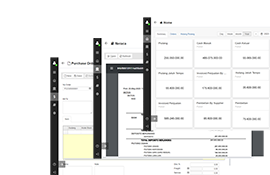
Photo credit: Pixabay
How to Create an Accounting Journal: What you need to know about Accounting Journal
Journal is a record of financial transactions carried out in a business and is the main recording system used to organize and store all financial information.
Journal includes accounts such as assets, liabilities, equity, revenue, and expenses. It is used to create financial reports, such as a balance sheet and income statement, that provide an overview of the financial condition of a business.
Each account in the journal has its own unique account number and is used to track certain types of transactions. Recorded transactions are grouped into debits and credits, and balanced so that the total debits equal the total credits.
In Swift, information in a journal consists of dates, accounts, debits, credits and information/notes as below.
| Date | Account | Debit | Credit | Description/Reference |
|---|---|---|---|---|
| 01-Feb-2012 | Account | X.XXX.XXX | 0 | ... |
Table of Contents:
Transaction Example
The following is an example of a parable of transactions that occurred at the Auto Service company during February 2012.
1) On 1 Feb 2002, Peter deposited USD 5,000 to the Auto Service company as the initial capital for his workshop business.
Transaction:
- Company cash (Assets) increased by USD 5,000. (Debit)
- Company capital (Equity) increased by USD 5,000. (Credit)
| Date | Account | Debit | Credit |
|---|---|---|---|
| 01-Feb-2002 | Cash | 5,000 | 0 |
| 01-Feb-2002 | Capital | 0 | 5,000 |
2) On 2 Feb 2002, Peter rented a shophouse for business by paying USD 2,000 for 6 months.
Transaction:
- Prepaid Rent (Property) increases by USD 2,000. (Debit)
- Company cash (Assets) decreased by USD 2,000. (Credit)
| Date | Account | Debit | Credit |
|---|---|---|---|
| 02-Feb-2002 | Prepaid lease | 2,000 | 0 |
| 02-Feb-2002 | Cash | 0 | 2,000 |
3) On 3 Feb 2002, Peter bought workshop equipment with cash for USD 1,000.
Transaction:
- Workshop Equipment (Assets) increased by USD 1,000. (Debit)
- Company cash (Assets) reduced by USD 1,000. (Credit)
| Date | Account | Debit | Credit |
|---|---|---|---|
| 03-Feb-2002 | Workshop Equipment | 1,000 | 0 |
| 03-Feb-2002 | Cash | 0 | 1,000 |
4) On 5 Feb 2002, Peter provided a customer's car service for USD 200 and was paid in cash.
Transaction:
- Company cash (Assets) increased by USD 200. (Debit)
- Service Revenue (Revenue) increased by USD 200. (Credit)
| Date | Account | Debit | Credit |
|---|---|---|---|
| 05-Feb-2002 | Cash | 200 | 0 |
| 05-Feb-2002 | Services revenue | 0 | 200 |
5) On 8 Feb 2002, Peter bought 12 jerry cans of oil from Toko Semesta for USD 600 and was only paid USD 200.
Transaction:
- Inventory of goods (Assets) increased by USD 600. (Debit)
- Company cash (Assets) reduced by USD 200. (Credit)
- Accounts payable (Debt) increased by USD 400. (Credit)
| Date | Account | Debit | Credit |
|---|---|---|---|
| 08-Feb-2002 | Inventory | 600 | 0 |
| 08-Feb-2002 | Cash | 0 | 200 |
| 08-Feb-2002 | Debt | 0 | 400 |
6) On 9 Feb 2002, Peter sold 6 jerry cans of oil for USD 420 and a service fee of USD 400 with cash payments.
Transaction:
- Company cash (Assets) increased by USD 820. (Debit)
- Inventory of goods (Assets) decreased by USD 300. (Credit)
- Income (Revenue) increased by USD 120. (Credit)
- Service Revenue (Revenue) increased by USD 400. (Credit)
| Date | Account | Debit | Credit |
|---|---|---|---|
| 09-Feb-2002 | Cash | 820 | 0 |
| 09-Feb-2002 | Inventory | 0 | 300 |
| 09-Feb-2002 | Income | 0 | 120 |
| 09-Feb-2002 | Services revenue | 0 | 400 |
7) On 11 Feb 2002, Peter provided a customer's car service for USD 500 with a cash payment.
Transaction:
- Company cash (Assets) increased by USD 500. (Debit)
- Service Revenue (Revenue) increased by USD 500. (Credit)
| Date | Account | Debit | Credit |
|---|---|---|---|
| 11-Feb-2002 | Cash | 500 | 0 |
| 11-Feb-2002 | Services revenue | 0 | 500 |
8) On 13 Feb 2002, Peter paid USD 400 for the purchase on 9 Feb 2002.
Transaction:
- Accounts payable (Debt) reduced USD 400. (Debit)
- Company cash (Assets) reduced by USD 400. (Credit)
| Date | Account | Debit | Credit |
|---|---|---|---|
| 13-Feb-2002 | Debt | 400 | 0 |
| 13-Feb-2002 | Cash | 0 | 400 |
9) On 15 Feb 2002, Peter paid his employees' salary for 2 weeks of work USD 200.
Transaction:
- Salary (Cost) increased USD 200. (Debit)
- Company cash (Assets) decreased by USD 200. (Credit)
| Date | Account | Debit | Credit |
|---|---|---|---|
| 15-Feb-2002 | Wages | 200 | 0 |
| 15-Feb-2002 | Cash | 0 | 200 |
10) On 20 Feb 2002, Peter received a loan from the bank of USD 5,000, with a bank admin fee of USD 100.
Transaction:
- Company cash (Assets) increased by USD 4,900. (Debit)
- Bank Adm Fee (Fee) will increase by USD 100. (Debit)
- Bank Debt (Debt) increased by USD 5,000. (Credit)
| Date | Account | Debit | Credit |
|---|---|---|---|
| 20-Feb-2002 | Cash | 4,900 | 0 |
| 20-Feb-2002 | Bank Administration fee | 100 | 0 |
| 20-Feb-2002 | Bank debt | 0 | 5,000 |
Journal as a whole as of 28 Feb 2002:
| Date | Account | Debit | Credit |
|---|---|---|---|
| 01-Feb-2002 | Cash | 5,000 | 0 |
| Capital | 0 | 5,000 | |
| 02-Feb-2002 | Prepaid lease | 2,000 | 0 |
| Cash | 0 | 2,000 | |
| 03-Feb-2002 | Workshop Equipment | 1,000 | 0 |
| Cash | 0 | 1,000 | |
| 05-Feb-2002 | Cash | 200 | 0 |
| Services revenue | 0 | 200 | |
| 08-Feb-2002 | Inventory | 600 | 0 |
| Cash | 0 | 200 | |
| Debt | 0 | 400 | |
| 09-Feb-2002 | Cash | 820 | 0 |
| Inventory | 0 | 300 | |
| Income | 0 | 120 | |
| Services revenue | 0 | 400 | |
| 11-Feb-2002 | Cash | 500 | 0 |
| Services revenue | 0 | 500 | |
| 13-Feb-2002 | Debt | 400 | 0 |
| Cash | 0 | 400 | |
| 15-Feb-2002 | Wages | 200 | 0 |
| Cash | 0 | 200 | |
| 20-Feb-2002 | Cash | 4,900 | 0 |
| Bank Administration fee | 100 | 0 | |
| Bank debt | 0 | 5,000 | |
| Total | 15,720 | 15,720 |





